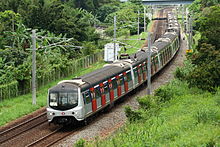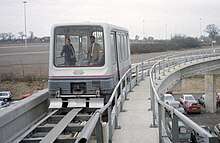
The Midland Railway Carriage and Wagon Company was a Birmingham, England, based manufacturer of railway carriages and wagons. It was not part of the Midland Railway.

The Birmingham Railway Carriage and Wagon Company (BRC&W) was a railway locomotive and carriage builder, founded in Birmingham, England and, for most of its existence, located at nearby Smethwick, with the factory divided by the boundary between the two places. The company was established in 1854.

British Rail Engineering Limited (BREL) was the railway systems engineering subsidiary of British Rail.
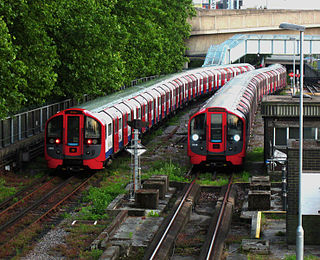
London Underground rolling stock includes the electric multiple-unit trains used on the London Underground. These come in two sizes, smaller deep-level tube trains and larger sub-surface trains of a similar size to those on British main lines, both running on standard gauge tracks. New trains are designed for the maximum number of standing passengers and for speed of access to the cars.

The Standard Stock title was applied to a variety of Tube stock built between 1923 and 1934, all of which shared the same basic characteristics, but with some detailed differences. This design is sometimes referred to as 1923 Tube Stock, 1923 Stock, or Pre 1938 Stock. Most of the Standard Stock was built to replace the first generation of "Gate Stock" Tube trains or to provide additional trains for extensions built in the 1920s and early 1930s. Standard Stock cars consisted of motor cars, with a driver's cab, behind which was a "switch compartment" occupying approximately one-third of the length of the car, plus trailer cars and "control trailers", with a driving cab but no motor. All were equipped with air operated sliding doors. The guard's door on the earlier trains was a manually operated, inward-opening hinged door.

Hyundai Rotem Co. is a South Korean company that manufactures rolling stock, defense products and plant equipment. It is a part of the Hyundai Motor Group. Its name was changed from Rotem to Hyundai Rotem in December 2007 to reflect the parent company. It is also called Hyundai Railroad Technology Systems.

Gloucester Railway Carriage and Wagon Company (GRC&W) was a railway rolling stock manufacturer based in Gloucester, England from 1860 until 1986. Products included goods wagons, passenger coaches, diesel multiple units, electric multiple units and various special-purpose vehicles. The company supplied the original fleet of red trains for the Toronto Subway, which were based upon similar vehicles to the London Underground. The company also produced pivoting sections for the Mulberry Harbour for the British War Office 1944.

Aston railway station serves the districts of Aston and Nechells in Birmingham, England. The passenger entrance is on Lichfield Road. The station is on the Cross-City Line and the Chase Line. It is one of two local stations for Aston Villa Football Club and near to the Aston Expressway and to Gravelly Hill Interchange.

The British Rail Class 501 electric multiple units were built in 1955/56 for use on the former LNWR/LMS suburban electric network of the London Midland Region. A total of 57 three-car units were built.

The British Rail Class 306 was a fleet of electric multiple unit (EMU) trains introduced in 1949. It consisted of 92 three-car trains which were used on the Great Eastern Main Line between Shenfield and London Liverpool Street.

British Rail Class 503 passenger trains were 65 mph (105 km/h) electric multiple units. They were introduced in two batches: the first were in 1938, by the London, Midland and Scottish Railway (LMS), with a further batch in 1956 by the then nationalised British Railways (BR). When introduced by the LMS, they were known officially as Class AM3. They were designed for, and operated on, the Wirral & Mersey lines from Liverpool to West Kirby, New Brighton and Rock Ferry. There were few places on their network of closely-spaced stations to attain their maximum speed, except for the open section between Moreton and Meols. All but one set were withdrawn and scrapped by 1985. The final set was used on special Merseyrail services until 1988; it was preserved and kept at the Electric Railway Museum near Coventry, until it moved on to the Locomotive Storage Ltd warehouse at Margate.
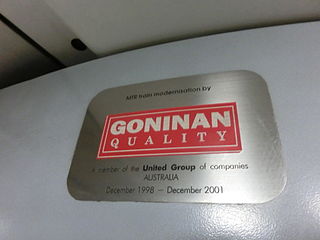
UGL Rail is an Australian rail company specialising in building, maintaining and refurbishing diesel locomotives, diesel and electric multiple units and freight wagons. It is a subsidiary of UGL and is based in Melbourne, with a staff of 1,200 across Australia and Asia. It operates factories in Broadmeadow, Maintrain Auburn, Spotswood and Bassendean. While it used to operate a factory in Taree, the plant was shut down and the equipment sold off.
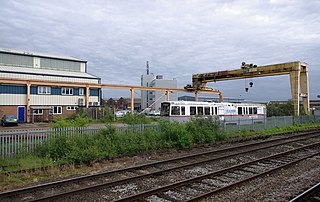
Derby Litchurch Lane Works, formerly Derby Carriage and Wagon Works, is a railway rolling stock factory in Derby, England. It is presently owned by the multinational transportation manufacturer Alstom.

Pullman trains in Great Britain were mainline luxury railway services that operated with first-class coaches and a steward service, provided by the British Pullman Car Company (PCC) from 1874 until 1962, and then by British Railways from 1962 until 1972. Many named mainline service trains have subsequently used the word 'Pullman' in their titles, but most of these have been normal trains with increased first-class accommodation. Since 1982 however, some railtours have been operated by companies using Pullman coaches dating from the 1920s to 1950s to recreate the ambience of the heyday of Pullman travel.

The East Rail line Metro Cammell EMU was a model of electric multiple unit built in 1980–1990 by Metro-Cammell for the original Kowloon–Canton Railway in Hong Kong. The 29 sets were owned by and were originally operated by the Kowloon-Canton Railway Corporation (KCRC). They were operated by MTR Corporation (MTRC) after it merged with KCRC in 2007. Although another set of EMU trains from the same manufacturer operate on some of MTR's own lines, there are some significant differences between the two models, with the Metro Cammell EMUs of the original MTR being known as the Modernization Train.

The Networker is a family of passenger trains which operate on the UK railway system. They were built in the late 1980s and early 1990s by British Rail Engineering Limited and Metro Cammell. The trains were built for the Network SouthEast (NSE) sector of British Rail, which is where their name comes from. They are all multiple-unit trains.
London's Metropolitan Railway (MR) amalgamated with other underground railways, tramway companies and bus operators on 1 July 1933, to form the London Passenger Transport Board (LPTB); the MR became the Board's Metropolitan line.

Diesel multiple units and railcars are trains, usually with passenger accommodation, that do not require a locomotive. Railcars can be single cars, while in multiple units cars are marshalled together with a driving position either end. As of December 2010, 23 percent of the rail passenger cars used on Network Rail are part of a diesel multiple unit.

The Vivarail D-Train is a family of multiple units remanufactured by Vivarail for the British rail network. They are converted from London Underground D78 Stock, originally manufactured between 1978 and 1981 by Metro-Cammell. Two versions have been produced: the Class 230 diesel electric multiple unit and the Class 484 electric multiple unit.










